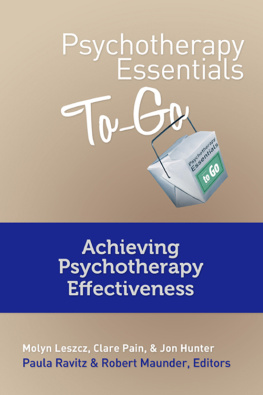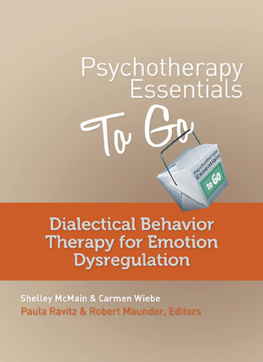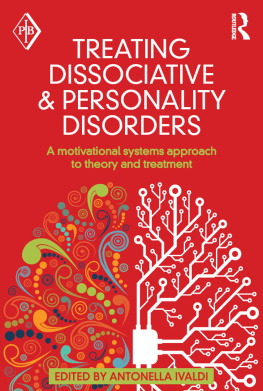Wayne Skinner, MSW, RSW, is Deputy Clinical Director in the Ambulatory & Structured Treatment Program at Centre for Addiction and Mental Health. An Assistant Professor in the Department of Psychiatry and Adjunct Senior Lecturer in the Factor-Inwentash Faculty of Social Work at the University of Toronto, he is Associate Editor (Canada) for the journal Mental Health & Substance Use and a member of the Motivational Interviewing Network of Trainers (MINT).
Carolynne Cooper, MSW, RSW, is a social worker at Torontos Centre for Addiction and Mental Health, and a member of the Motivational Interviewing Network of Trainers. She works with groups and individuals using a number of models of psychotherapy for a range of clinical problems such as depression, anxiety, bipolar illness, and addictions, including substance abuse and gambling.
Paula Ravitz, MD, is Associate Professor, Morgan Firestone Psychotherapy Chair, and Associate Director of the Psychotherapy, Health Humanities, and Education Scholarship Division for the Department of Psychiatry at the University of Toronto, where she leads IPT training. She is also the director of the Mt. Sinai Psychotherapy Institute. Her clinical practice, teaching, and research focus on IPT and attachment-informed psychotherapy.
Robert Maunder, MD, is Associate Professor in the Department of Psychiatry at the University of Toronto and head of research for Mount Sinai Hospitals Department of Psychiatry. His primary research interest is the role of interpersonal attachment on health.
Producing Psychotherapy Essentials to Go has depended on and benefited from the support and expertise of many people. We wish to acknowledge and thank William Miller and Stephen Rollnick, the developers of Motivational Interviewing (MI), who with others have built the foundation from which this treatment has grown. We are grateful to the contributing authors whose hard work, wisdom, and creativity as educators and clinicians are represented; the Ontario Ministry of Health and Long Term Care, who provided funding to the educational outreach pilot project team of the Northern Psychiatric Outreach Program at the Centre for Addiction and Mental Health (CAMH); Nancy McNaughton and the University of Toronto Standardized Patient Program; Robert Swenson and the Ontario Psychiatric Outreach Program; the University of Toronto Department of Psychiatry; the Mount Sinai Hospital Department of Psychiatry; Molyn Leszcz and the Morgan Firestone Psychotherapy Chair; Scott Mitchell; the Canadian Mental Health Associations northern Ontario branch executive directors and healthcare workers; and Andrea Costella Dawson and Sophie Hagen of W. W. Norton. We also wish to thank Robert Cooke, the CAMH, the actors who brought the material to life, Tom and Reet Mae and Ryan Hannabee of Mae Studios, Bhadra Lokuge, Connie Kim, and Lynn Fisher.
OTHER TITLES IN THE SERIES INCLUDE:
Cognitive Behavioral Therapy for Depression
Mark Fefergrad & Ari Zaretsky
Cognitive Behavioral Therapy for Anxiety
Mark Fefergrad & Peggy Richter
Interpersonal Psychotherapy for Depression
Paula Ravitz, Priya Watson, & Sophie Grigoriadis
Dialectical Behavior Therapy for Emotion Dysregulation
Shelley McMain & Carmen Wiebe
Achieving Psychotherapy Effectiveness
Molyn Leszcz, Clare Pain, Jon Hunter, Paula Ravitz, & Robert Maunder
A NORTON PROFESSIONAL BOOK
REFLECTIVE LISTENING
The foundation for effective reflection is the ability to attend and listen to the client. That is the well of experience from which we draw our observations. Therapeutic listening is intended to refer to all of thatit refers to what we see visually, to body language, and to all the ways of observation that are available to us in our helping role. As we draw from it, there are some helpful tips to consider, such as reflecting in a focused way, keeping it concise, doing it frequently, and trying to tip our comments toward positive, change-oriented material. Remembering to follow the clients pace and give time for feedback is essential. This is about tuning yourself to the client and trying to get in sync with him or her. This, of course, involves understanding and validating the clients feelings and thoughts of ambivalence.
Types of Reflective Listening (Rosengren, 2010)
Simple: Stays close to what the person said; communicates interest; centers the client
Complex: Goes beyond what was said and may not involve the same words; may cognitively reframe the material; infers greater meaning; may include affect
Double-sided : Identifies and acknowledges both sides of ambivalence
Metaphor : Moves beyond content to offer a model for understanding
One of the strengths of reflective listening, which is the most essential OARS skill, is that there is a fair range of responses to draw on. When stuck, or just getting your bearings, it is useful to keep it simple. As you have more empathic understanding of the client, the response can be more complex and potent. Being able to go beyond just simple reflections is an important skill in MI. It requires practice, and practice is best done when feedback, coaching, and supervision are available.
Deepening Reflections
As the therapist moves beyond simple reflections, there are three key ways he or she can employ reflective listening to help clients hear themselves speak.
Paraphrasing: Move beyond the clients words to present information in a new light
Double-sided: Reflect both sides of the clients ambivalence
Affective : Address emotional content, either expressed or implied
The connection and deep understanding that develop with reflective listening allow the therapist to have a strong compassionate understanding. That leads to the opportunity not just to always question the client but also to tentatively make observations and reflections that are informed by deeper awareness of how it is with the client, not only in terms of deficits, problems, and concerns but also desires, goals, strengths, and aspirations.
Reflective listening involves making statements, not asking questions.
RESPONDING TO RESISTANCESOUND-BITES
1. Simple reflection: Responding to resistance with nonresistance; sometimes includes small shift in emphasis; acknowledgment of the clients perception or disagreement.
Example:
Client:I couldnt change even if I wanted to.
Therapist: You cant see any way you believe in and you might fail if you tried.
2. Double-sided reflection: Acknowledging what the client has said and adding to it the other side of the clients ambivalence, using material the client has offered previously.
Example:
Client:I dont smoke any more than most of my friends.
Whats wrong with smoking a joint now and then?
Therapist: I can see how this could be confusing. On the one hand, youve told me youre concerned about how smoking affects you, and on the other hand, it seems youre not using any more than your friends. Hard to figure out!
3. Shifting focus: Shifting the clients attention away from what seems to be a stumbling block in the way of progress.
Example:
Client: Okay, maybe Ive got some problems with drinking but Im not an Alkie.
Therapist:I dont think thats the issue at all whether you consider yourself an alcoholic. I am wondering about some of the things that seem to be happening in your life. Tell me a little more about...
4. Reframing: Reframing information the client has offered; acknowledges the validity of the clients raw observations but offers a new meaning or interpretation of them.
5. Emphasizing personal choice and control: Assuring the person of what is certainly the truth: that in the end, it is the client who determines what happens (can be inserted early in the process).
Next page












